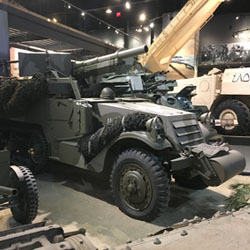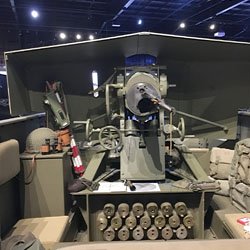The M3 Gun Motor Carriage (GMC) was a United States Army tank destroyer equipped with a 75 mm M1897A4 gun, which was built by the Autocar Company during World War II.
After observing the new and often decisive, uses of armored vehicles on both sides during the French campaign of 1940, the US Army decided that it required a 75 mm self-propelled gun, based on the chassis of the M3 Half-track. This was initially known as the T12. However, after the addition of features such as the gun shield from the M2A3 (a carriage for the M1897A4), the new vehicle entered production under the name M3 Gun Motor Carriage (or M3 GMC). Because the number of M2A3 gun shields available was insufficient for the M3 GMC order, a new gun shield was designed. Variants featuring the new shield were designated M3A1 GMC.
The T12/M3 first served in the Philippines Campaign in 1942 with the Provisional Field Artillery Brigade in the anti-tank and the fire-support role. It then served in North Africa in tank destroyer battalions. It was used ineffectively in the Battle of Kasserine Pass and several other engagements, but was used with success in the Battle of El Guettar. It also served in the Allied invasion of Sicily, but was eventually superseded by the M10 tank destroyer. A total of 2,203 were produced, of which 1,361 were converted back into M3A1 half-tracks.
The M3 GMC also served in the Pacific theater, starting with the Battle of Saipan. It proved effective against the Japanese Type 95 Ha-Go and Type 97 Chi-Ha tanks. It later served in the Battle of Okinawa, the Battle of Peleliu and many other island battles.
The M3 was armed with one 75 mm M1897A5 with 59 rounds, had 0.25–0.625 in (6.4–15.9 mm) of armor, and a crew of five consisting of a commander, gunner, two loaders, and a driver. Firing the M61 armor piercing round, the gun could penetrate up to 3 inches (76 mm) of armor at 1,000 yards (910 m).
The T12/M3 GMC first saw action with the U.S. Army in the Philippines in 1941–42, six months after it was designed. Fifty were shipped on convoys to the Philippines in the late summer and fall of 1941. Three battalions of the Provisional Field Artillery Brigade operated T12s against the Japanese when they invaded the Philippines. During the early part of the campaign, the vehicle was used to provide direct covering fire and anti-tank support. The Japanese captured a few vehicles in 1942 and used them in the defense of the Philippines.
By 1942, M3 GMCs were being used by tank destroyer battalions in the North African Campaign. The M3 GMCs, which were designed for ambushing tanks, proved to be inadequate for this task in the battles of Sidi Bou Zid and Kasserine Pass, mainly due to poor tactics. Nevertheless, the M3 was later used in the Battle of El Guettar with success, claiming 30 German tanks, including possibly two Tiger tanks, at the cost of 21 M3s. Some M3s also saw service in Allied invasion of Sicily (Operation Husky), but by that time, the M10 tank destroyer had replaced it in the U.S. Army. A total of 1,360 M3 GMCs were also converted back into M3A1 half-tracks.
The M3 also served with the U.S. Marines in the Pacific Theater of Operations and was first used in the invasion of Saipan. It proved highly effective against the Type 95 Ha-Go and the Type 97 Chi-Ha, in the fight against the Japanese 9th Tank Regiment on Saipan. It also served in the Battle of Peleliu and the Battle of Okinawa, and many other conflicts in the Pacific.
The battle on the island of Saipan in the Mariana Islands lasted from 15 June to 9 July 1944. The loss of Saipan, with the deaths of at least 29,000 troops and heavy civilian casualties, precipitated the resignation of Prime Minister of Japan Hideki Tōjō and left the Japanese archipelago within the range of United States. Saipan became a major base for B-29 bombers flying to Japan and back.






